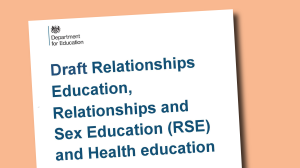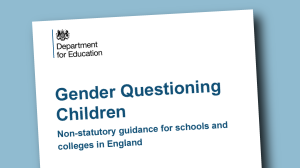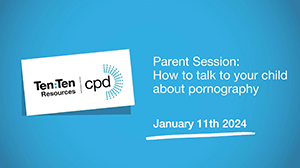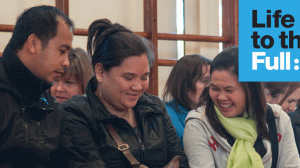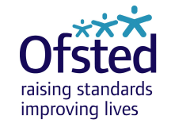
Each year on 10th October, the World Health Organization celebrates World Mental Health Day to raise awareness of mental health issues around the world and to mobilise efforts in support of mental health.
All aspects of Ten Ten’s Life to the Full programme at both primary and secondary level take a holistic approach, incorporating good practice regarding mental health throughout all sessions, not just those specifically about emotional well-being. To celebrate World Mental Health Day this year, we are sharing with you some guidance for teaching staff that was originally produced as part of an UKS2 session, but which is useful for all parents and educators.
How to Talk About Feelings
Throughout Life to the Full, pupils learn that feelings are not in and of themselves ‘good’ or ‘bad’ – whilst we might describe the effects of them as good or bad, positive or negative, comfortable or uncomfortable; there are no good or bad feelings, just feelings which give us information about how we are responding to our experience. This is the most crucial piece of guidance to take away!
This article provides some information and guidance about how to talk about feelings at a deeper level, further developing the emotional intelligence and emotional regulation of children in your care. Some of the information below you might want to share/discuss with pupils, particularly those working at a higher level, and some of the information will serve more usefully as guidance for staff in terms of what to say – and what not to say.
This guidance does not aim to be exhaustive, but provides an insight into the following:
Emotions vs feelings
What’s the difference between ‘emotions’ and ‘feelings’?
‘Emotions’ and ‘feelings’ are often used interchangeably, but they really aren’t the same thing:
Emotions are chemicals released in the body as a response to our interpretation of a specific trigger.
Feelings are the names we give to our perceived experience of the emotion chemicals working in our bodies.
Take for example, the physiological experience of your body being hyper-alert, pumped full of adrenaline, clammy hands and heart beating fast…
That might be described as the feeling of ‘fear’ when walking down a dark alley and hearing footsteps behind you; or as the feeling of ‘excitement’ when you’re about to meet your favourite pop-star at a VIP meet-and-greet.
Neither description is ‘right’ or ‘wrong’, but simply a conscious description of how we are interpreting a specific trigger and physiological experience.
To summarise, feelings are experienced consciously, while emotions manifest either consciously or subconsciously.
'Controlling' vs 'managing'
Is it better to use ‘controlling’ or ‘managing’ when we talk about actions, feelings and thoughts?
These words, used in different circumstances, can have very different implications. Read on to dig deeper into how these words might be perceived and how they might contribute to a child’s unconsciously created ‘scripts’ or ‘beliefs’ about their emotions. To structure this section, we use the CBT (Cognitive Behaviour Therapy) Model of Emotions as used in Life to the Full primary programme: actions, feelings and thoughts.
Actions
- People often use the phrases ‘control yourself’ or ‘control your temper’, and using ‘control’ in these scenarios is perhaps understandable, because there are certain behaviours that are just inappropriate, no matter how we are feeling or what is going on, e.g. putting someone in a headlock because we’re feeling angry!
- Using the word ‘control’ in these scenarios implies a sense of intervention, which is accurate when we might need to hold ourselves back from doing something we really want to do, because we know it is inappropriate.
- However, ‘control’ also has an implied opposite: if we are not ‘in control’ then we must be ‘out of control’ which could instigate an unhelpful shame response to emotion. A better way to communicate about behaviour is in terms of ‘management’, e.g. ‘How can I manage this situation well?’ or ‘What could you have managed differently there?’
Feelings
- We cannot, and should not, try to ‘control’ our emotions, e.g. by pretending they don’t exist, bottling them up inside, shaming ourselves because we decide that they are wrong and we should feel something else, trying to eliminate them etc.
- Instead, we should try to ‘manage’ or ‘regulate’ our feelings – the conscious experience of our emotions. This means being curious about our feelings, which neither good nor bad, give us information about what we are experiencing. They reveal to us what is going on, and how we might want to respond. At a very basic level, emotions help us to identify when we are in danger either physically or emotionally.
- However, feelings are not facts. Just like we need to fact-check things we read online, we need to fact-check our feelings, e.g. ‘Am I labelling my feelings in response to accurate evidence? Are there any confounding factors affecting my response?’ This is where thoughts come in…
Thoughts
- When it comes to thoughts, the vast majority of our thinking goes on subconsciously, so we cannot ‘control’ this.
- However, when we experience conscious thought, we can choose to ‘observe’ them. E.g. We can observe our thoughts as if they are visitors passing in and out of a room. Some visitors we may like, others we may not, and some we may feel indifferent about. Whatever the case may be, we can just greet each visitor, briefly observe each one, and then watch each visitor exit.
- When we do this, we are able to choose which thoughts to follow, re-direct or re-frame as appropriate. This is another example of ‘managing’ rather than ‘controlling’.
When we allow ourselves space to observe and be non-judgmentally curious about our thoughts and feelings, we are in a much better position to make well-informed, wise choices about how to manage our behavioural responses.
What is ‘emotional regulation’?
‘Emotional regulation’ is a term generally used to describe a person’s ability to effectively manage and respond to an emotional experience. Healthy emotion regulation includes components such as:
- Recognising the experience of having an emotional response and seeking to understand what that response means to us through objective curiosity.
- Accepting one’s own emotional responses rather than rejecting them or reacting to them with fear.
- Understanding the potential impact of emotional responses on behaviour.
- Taking steps to manage emotional responses in a positive way.
Secondarily to the above components is understanding that the emotions and expressed feelings of others can interplay with our own. A child’s emotional development is particularly affected – positively or negatively – by watching and learning from others. Understanding the effect that the emotions and expressed feelings of others can have on us, whilst maintaining a commitment to emotional self-awareness and regulation, is a marker of emotional intelligence.
Help children to manage emotions
How can parents and educators help children to manage their emotions well?
The most important thing parents and educators can do to help children and young people to manage their emotions well is to validate their feelings as neither good nor bad, but as information about which they should be curious and make informed, well-managed choices. In practice what this means is:
- When a child shares their feelings with you (requested or unrequested), receive their description of their experience without judgement.
- Demonstrate curiosity; do not shame children or young people for naming any particular feeling, but gently encourage them to explore the factors involved. You can remind them that ‘feelings are not facts’ without invalidating their experience of that feeling.
- Help children to build their emotional vocabulary. Showcase how you might express a feeling, discover that the word isn’t quite right and come up with a new way to describe the conscious awareness of emotion.
- Make a habit of linking feelings with the physiological experience of emotion in the body and practise naming these experiences as feelings, e.g. ask children ‘Where is that feeling in your body? What is it like? Can you find a name for it?’
- Develop emotional awareness of selves and others through reading stories and inviting children to notice and comment on the thoughts, feelings and actions of the characters.
Techniques to manage feelings
The Life to the Full programme supports the viewpoint that feelings are not facts: we should always fact-check our feelings, particularly in moments where we are tempted to do something (e.g. out of anger) that deep down we know is inappropriate.
Below is a toolkit of techniques to help people of all ages to manage their feelings well, particularly in moments of high emotion. Many of these are variations on a similar theme of stopping to explore thoughts and feelings before taking action – different techniques will be useful at different times, and some people will resonate more with some than others.
- Consider other factors that could be contributing to feelings by stopping to ask HALT – Am I Hungry, Angry, Lonely or Tired?
- Taking time out
- Slowly counting 1 – 10
- Going for a walk outside
- Doing some breathing exercises
- Doing something creative
- Writing what you are angry about on a piece of paper and then tearing it into little bits, or returning to it later to see if the feelings are justified
- Stop, Think, Decide, Do:
- Stop – Before you act on feelings, stop.
- Think – Consider: ‘Is this a good choice? What should I do next?’
- Decide – Assess whether or not it’s a good course of action.
- Do – Put good behaviour choices into action.
- The 3 C’s of CBT: Catch, Check, Change
- Catch – Identify the thought that came before the feeling.
- Check – Reflect on how accurate and useful the thought is.
- Change – Change or reframe the thought to a more accurate or helpful one as needed.
- Remembering happy memories or listing things you are thankful for
- Telling an adult you trust about how you feel e.g. God, your parents/carers, teachers etc.
Using appropriate language around feelings
Why is it so important for parents and educators to use appropriate language around feelings in particular?
How adults react to children’s emotions, in real time as they are happening or in sessions where they are teaching about them, has a huge impact on children’s emotional development. For parents and educators, it is important to be particularly mindful around language to do with feelings, and also to model healthy emotional regulation themselves, as children are always learning and often will imitate what they see.
Sources and further reading
- Emotions, Feelings and Moods: What’s the Difference? (Six Seconds: The Emotional Intelligence Network)
- How to Check the Facts (Mindsoother Therapy Centre)
- An Age-by-Age Guide To Helping Kids Manage Emotions (The Gottman Institute: A Research-based Approach to Relationships)
- Understanding the chemicals controlling your mood (CBHS Health)
- The Difference Between Feelings and Emotions (Wake Forest University)
- Emotions in Context: What We Know About How We Feel (Association for Psychological Science)
- How Emotion Shapes Behaviour: Feedback, Anticipation, and Reflection, Rather Than Direct Causation (Personality and Social Psychology Review)
- Can Emotions Be Controlled? (Psychology Today)
- 21 Common Reactions to Trauma (Psychology Today)
- What’s the Difference Between a Feeling and an Emotion? (Psychology Today)
- Using the Mnemonic “Three Cs” with Children and Adolescents (The Beck Institute)













